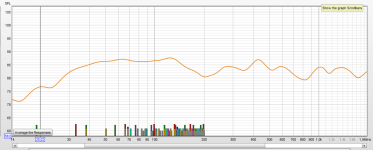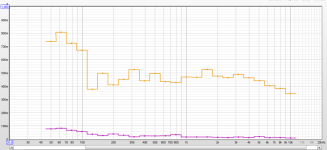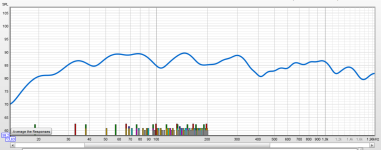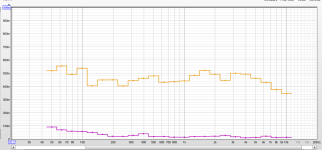@krivium , thanks, question : the Qts measurements you refer to , with what voltage and Rsense value was that done? I am testing influence of voltage on speaker and from 0.1V to 1V it varies significantly and from 2.83V or higher virtually no variations.I find 0.577 more real or true. It's difficult to express by words but with 'real' (acoustic) instruments i find it closer to real life sound ( i can often compare to real instruments including double bass).
As i'm lucky to have easy access to outdoor i heard the lack of overshoot 0,577 qtc have too vs other qtc like 0,707 or 1 or more and i think i can identify it too in a room but i've not performed any abx about it so i maybe fool myself with this.
That said i listen mostly below or at critical distance with time aligned system so it might play a role too?
Hi JanRSmit,
I don't do it that way: a closely located mic, a template of freq response i target ( Qtc and fc) and from there i tweak dsp eq for template and mic response to match.
Level i do it is circa 90dbspl and is arbitrary fixed because of my mic limitation ( i don't trust it at level above 94dbspl). When not lazy i measure driver parameter ( or use datasheets parameters) and play with Linkwitz transform simulation to have an idea of what to target but i found it's ok to do it without too, it takes a bit more time to reach target though but with 2 bands it's enough so not this long overall.
I did this kind of things with different drivers ranging from 6,5" to 15" and often outside their recommended use ( drivers i had access to are more often BR dedicated than recomended for closed or sealed) however as long as you don't go crazy with very low fc and high spl level it's often more than ok.
For the voltage sent to them it varie: a 6,5" won't need the same voltage as a couple of 12" or a medium efficiency 15" ( in the 92 to 94dbspl/1w/1m).
I don't want to hijack the thread maybe we could continue in pm? Feel free to contact me.
I don't do it that way: a closely located mic, a template of freq response i target ( Qtc and fc) and from there i tweak dsp eq for template and mic response to match.
Level i do it is circa 90dbspl and is arbitrary fixed because of my mic limitation ( i don't trust it at level above 94dbspl). When not lazy i measure driver parameter ( or use datasheets parameters) and play with Linkwitz transform simulation to have an idea of what to target but i found it's ok to do it without too, it takes a bit more time to reach target though but with 2 bands it's enough so not this long overall.
I did this kind of things with different drivers ranging from 6,5" to 15" and often outside their recommended use ( drivers i had access to are more often BR dedicated than recomended for closed or sealed) however as long as you don't go crazy with very low fc and high spl level it's often more than ok.
For the voltage sent to them it varie: a 6,5" won't need the same voltage as a couple of 12" or a medium efficiency 15" ( in the 92 to 94dbspl/1w/1m).
I don't want to hijack the thread maybe we could continue in pm? Feel free to contact me.
The house was quiet for a second, had to move the sub and try this.It would be interesting to see if you could pick the alignments from the decay graphs any better.
My sweetspot is front of sofa, but I'm often sitting at the sofa, using mic on stand front of sofa, and just rotate the boom to get the listening spot, left and right, and then sofa position. Measured LR playing together and SUB, then using the alignment tool exported aligned sums with 2ms delay intervals, and zoned in to lowest decays around 60-100Hz which seems to be most problematic for some reason. Zoned into a delay time, checked same delay with all the measurements and indeed decay times better on all of them.
Adjusted EQ some to knock out worst offender around 60Hz, and it didn't seem to affect decays much. If I did more EQ, there stareted to be some differences.
Frequency response is now different than before of course so hard to directly compare, need to listen for some time. From this quick experience it seems it's possible to adjust the decay times and frequency response somewhat separately: Use position and delay / phase adjustment to make lowest decay times, and then adjust with EQ if necessary.
Here, one sub and mains, sub on the left wall on the first images and adjusted using all tricks to make nice nice frequency response, never though to check decay times. Decay times shoot up around 100Hz and below.


Here sub is on the back wall and delay adjusted for lowest Decay times, and then some quick EQ


These are from separate days so mic was likely bit different position, toe-in is different, sofa is likely bit different position and so on 😀 Just a demonstration that frequency response and decay times can be adjusted somewhat separately, even with one sub. Not sure how big audible difference is as I can't AB them due to sub position changed.
Subwoofer behind listening spot have been nice, I think it works as good as any position and setting I've had it. Hard tp say if it is best position and setting but seems to work nicely.
One particularly nice thing is that when it's behind listening spot it localizes on the front for some reason. I tried higher low pass frequency, and it still is "invisible", compared to when the sub was left of the listening spot I had to really drag down the low pass and use steeper slope and it would still localize there sometimes. Same happens now if I move enough to side, but sitting at the spot there is very little if any hint where the sub is located at.
One particularly nice thing is that when it's behind listening spot it localizes on the front for some reason. I tried higher low pass frequency, and it still is "invisible", compared to when the sub was left of the listening spot I had to really drag down the low pass and use steeper slope and it would still localize there sometimes. Same happens now if I move enough to side, but sitting at the spot there is very little if any hint where the sub is located at.